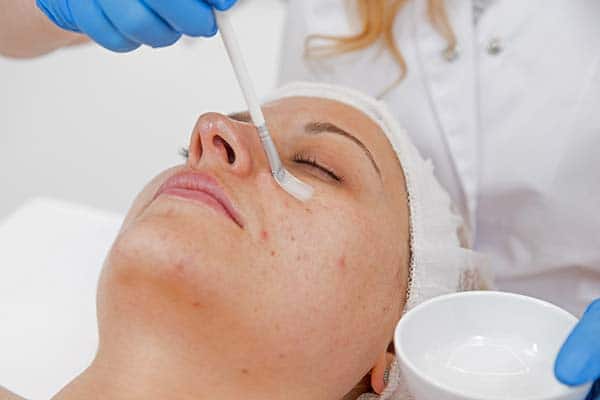Chemical peels
Chemical peels treatment overview
Chemical peels offer an effective way to treat the signs of skin ageing, acne, pigmentation and the reduction of pore size. Peels are available in a range of depths and concentrations to suit all skin types and lifestyles.
Skin cells are initially formed deep in the basal layer then slowly migrate to the surface epidermis where they form sheets of dead skin cells. As we age the rate at which the older skin cells are replaced with new fresher ones is reduced which can cause a dull appearance.
Chemical skin peels work by removing the outermost superficial layer of dead cells to reveal the newer fresher more vibrant cells below. This can help resurface the skin to improve fine lines, skin laxness, tone and texture as well as combating acne by the selection of anti-microbial chemical peel agents.
Chemical peels are a credible option to ablative therapies such as laser therapy. The treatment is more comfortable, has a much shorter downtime and is a fraction of the price. Note: No two chemical peels are the same, here at Rejuvenate we pride ourselves on selecting materials that are paraben, SLS, artificial dye and fragrance-free. Our products are gentle on your skin and naturally complement your current skincare routine. We typically use Glycolic peels at 40%; however as Dr Joe Dowie is medically qualified, he can offer up to 70% Glycolic peels if needed.
Watch a video of a live chemical peel treatment
Not sure what to expect during the actual treatment? Take a look at a chemical peel applied live at one of our popular demonstration events.
Where can I have chemical peels?
For anti-ageing, the most popular treatment areas are the face, neck and hands. With acne treatments, the face and back are the most popular.
At what age should I start chemical peel treatment?
You will see a benefit from having this treatment in your twenties onwards. Those in the 20s – early 30s typically need fewer treatments in a year (every 6-12 months). For people in their late 30s-40s onward, you will usually benefit from more regular sessions (every 3-6 months).
Does it hurt to have a chemical peel?
Glycolic skin peels work on the superficial epidermal skin layer. Because of this, they are a very gentle and safe way to achieve the look you want, without any pain or downtime. When the chemical peel is applied, you will feel a mild tingling sensation as it begins to work its magic. This is left on for between 1-5 minutes depending on which session you are on. The peeling agent is then softly inactivated with a buffering cream to safely restore your skins natural pH.
Will I be able to go back to work after my treatment?
The downtime with Glycolic chemical peels is minimal to non-existent depending on skin type. Patients are usually able to fit in treatments during their lunch break and going back to work afterwards. As the skin peel targets only the superficial layer, it safely resurfaces the uppermost layer of the skin without causing sheets of skin to shed off, making it an almost invisible peel.
How many sessions do I need before I see a difference?
From the very first session, your skin will feel cleaner and fresher. However for more defined improvements in skin tone, pigmentation and texture, a course of between 3-6 sessions is usually required, with 4 weeks between each session. It takes 40 days for new skin cells to migrate from the basal layer to the surface layer. It’s this natural process that we are encouraging, and as such creates the delay between treatment and results.
Do I need extra sessions of chemical peels to maintain my results?
Once you have achieved the result you are after (typically in 3-6 sessions), we recommend a single session every 3-9 months depending on your skin tone to promote and maintain your new fresher and healthier skin tone.
What does it cost for chemical peel treatment?
Here at Rejuvenate, price is determined by the number of sessions booked. We usually recommend 3-6 sessions initially to accomplish the skin enhancements you desire, with each session spaced 4 weeks apart. Then a single session every 3-6 months to help maintain the skin improvements achieved.
Sessions are charged at £70 per session, so a block of three treatments would cost £210 and a block of six treatments £420.
Chemical peel aftercare
Post-treatment you will be provided with an aftercare pack. This information will help you to know what to expect after your treatment:
- Once the procedure has been completed, the clinician will cleanse the area, apply a hydrating and SPF factor cream.
- The treated area may resemble light sunburn and feel warmer and tighter than usual. This reduces typically by 50% within 10 mins – 1 hour and will usually recover within the same day. You should see only very slight redness the following day.
- Use lukewarm water to cleanse the face for the following 48 hours and dry gently. Always make sure hands are clean when touching the treated area. It is recommended that make-up is not applied for 12 hours after the procedure. You may use a specialist mineral-makeup.
- A broad spectrum UVA/UVB sunscreen with an SPF 50 is applied after the treatment.
- Continue to use SPF50 sunscreen for 2 weeks.
- The skin may feel drier or tighter, typically 3-5 days post-treatment. This is normal, use Moisturiser and SPF50 as per recommendations.
- Resume recommended anti-ageing skincare regime once erythema (redness) has gone.
- Please do not use any Retinol products for 4 weeks.
- Avoid sunbeds, sunbathing, saunas or steam baths for 7 days after the peel.
- Do not swim in chlorinated water for 5 days post peel.
- Above all, if you have any concerns, please contact the practice. We are on North Street, Dudley, West Midlands. Full details on the contact page.

